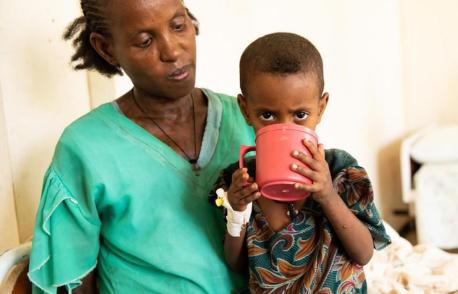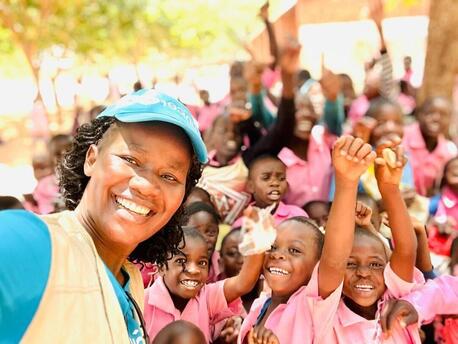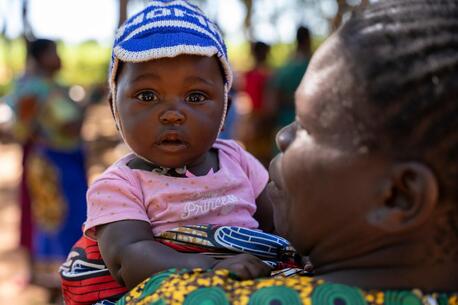
Crisis in Ethiopia: UNICEF Seeks Support to Step Up Tigray Relief
UNICEF is reaching tens of thousands of children every month with critical health and nutrition support and other humanitarian assistance. But the current emergency response plan calls for doing a lot more. And that will require closing a significant funding gap.
Before COVID-19 forced Ethiopia to close its schools in March 2020, Merhawit, 16, was at the top of her class in physics. When conflict erupted in the Tigray region in November 2020, she hadn’t seen the inside of a classroom for eight months. She walked 200 miles in broken flip flops, her baby brother strapped to her back, to escape the violence.
With no end in sight to the conflict — and no timeline for reopening schools, many of which are being used to shelter families displaced by the fighting — Merhawit spends most of her time searching for food.
Millions of children and their families continue to face violence and deprivation
UNICEF spokesperson James Elder met Merhawit during a recent field visit to assess the crisis in Ethiopia and UNICEF's ongoing response. So far UNICEF has reached 425,000 people through its humanitarian relief efforts, but the scope of the country's needs are far greater. More than 3 million people have been displaced, and vulnerable children and families continue to face grave risks to their health and safety.

A mobile health worker gives 21 packets of Ready-to-Use Therapeutic Food (RUTF) to a mother whose child is suffering from severe acute malnutrition at the UNICEF-supported Mai Tsebri site for families displaced by fighting in northern Ethiopia's Tigray region. UNICEF spokesperson James Elder described the ongoing crisis as "an education and nutrition emergency" as well as a protection crisis involving severe and ongoing child rights violations. He called on supporters to help UNICEF reach more children in need by closing funding gaps. An estimated 12.1 million children in Ethiopia are in need of humanitarian assistance due to the conflict that erupted in November 2020, on top of the health and socio-economic impacts of the COVID-19 pandemic. © UNICEF Ethiopia/2021/Nahom Tesfaye
“We have been very concerned from the onset about the harm this crisis will cause to children,” Elder said during a press briefing shortly upon his return to Geneva. “Such fears are now being realized.
"This is a protection crisis. What is emerging is a disturbing picture of severe and ongoing child rights violations ... The personal statements I have received from children who had been raped or testimonies of women who were victims of sexual violence were harrowing ... I heard traumatic stories from survivors, one as young as 14. I heard reports of gang rapes. The level of cruelty described in these attacks was bewildering."
At one site UNICEF supports, from January through mid-April, an average of three cases of gender-based violence were reported per day.
Poor conditions at displacement sites magnify the risks of child exploitation
Overcrowded, unsanitary and generally poor conditions at displacement sites magnify the risks of exploitation, and "make it impossible for people to practice COVID-19 prevention measures," Elder added. "From a health perspective, the presence of large numbers of displaced people is a ticking time bomb, especially as the rainy season approaches — that’s next month — when there will be a grave risk of cholera and other waterborne diseases."
As long as the fighting continues, access and security will remain serious issues, Elder said. Violence and looting have caused "extensive destruction" to health clinics, water systems and other critical infrastruture, crippling essential services and creating "an education and nutrition emergency."
UNICEF is working to protect children from an education and nutrition emergency
Conflict interrupted the 2020 harvest, erasing farmers' income for the whole year. Many had cattle stolen. It is time to start planting again, but farmers are displaced and can't access their land, or get fertilizer and other supplies.
"We are seeing a spike in malnutrition in a region that had already seen steep year-on-year increases in malnourished children requiring lifesaving treatment prior to this crisis," Elder said. Malnutrition among pregnant and lactating mothers is also on the rise.

Birkey Negassi, above with her 2-year-old son Haftom, left her village when the fighting started as part of the ongoing conflict in Tigray. It took one week for the family to walk to the Mai Tsebri center where UNICEF is working with partners to meet the urgent needs of displaced children and families. “I lost all my belongings — the chairs, the refrigerator, even our cattle,” she says. “Life was good before we came here. I don’t know why this is happening to us.” © UNICEF Ethiopia/2021/Demissew Bizuwerk
Here are some of the ways UNICEF is reaching vulnerable children and families in Tigray
Key components of UNICEF's response include:
- dispatching mobile health and nutrition teams to provide emergency medical care, immunizations, therapeutic food and other support, including screening and treatment for severe acute malnutrition
- leading efforts to rehabilitate damaged or nonfunctioning water systems and otherwise replenishing safe water supplies by trucking it in or treating local sources
- assisting survivors of sexual assault with medical and psychosocial support and dignity kits
- deploying social workers to manage child protection cases, which includes reuniting separated children with their families
- establishing temporary learning spaces for refugees, internally displaced children and children in host communities and providing learning materials
With humanitarian access opening up, UNICEF has revised its response plan to better match population needs. UNICEF’s Tigray Emergency Response Plan through September 2021 aims to reach 2.8 million people, including 1.3 million children, but it remains significantly underfunded.
Help UNICEF step up its humanitarian work in Ethiopia. Your contribution can make a difference.
Top photo: Mulu, 3, in treatment at the stablization center at Mai Tsebri Primary Hospital in Tigray, Ethiopia, drinks therapeutic milk provided by UNICEF as part of the ongoing humanitarian response in the embattled region. “I am glad that she is in good hands here,” says her mother, Teje, who made the hourlong journey to the hospital on foot, concerned about her daughter's vomiting and diarrhea. UNICEF is supporting health facilities serving those who have been displaced by the conflict, providing packets of Ready-to-Use Therapeutic Food (RUTF) in addition to therapeutic milk, among other lifesaving supplies. © UNICEF Ethiopia/2021/Demissew Bizuwerk
HOW TO HELP
There are many ways to make a difference
War, famine, poverty, natural disasters — threats to the world's children keep coming. But UNICEF won't stop working to keep children healthy and safe.
UNICEF works in over 190 countries and territories — more places than any other children's organization. UNICEF has the world's largest humanitarian warehouse and, when disaster strikes, can get supplies almost anywhere within 72 hours. Constantly innovating, always advocating for a better world for children, UNICEF works to ensure that every child can grow up healthy, educated, protected and respected.
Would you like to help give all children the opportunity to reach their full potential? There are many ways to get involved.





